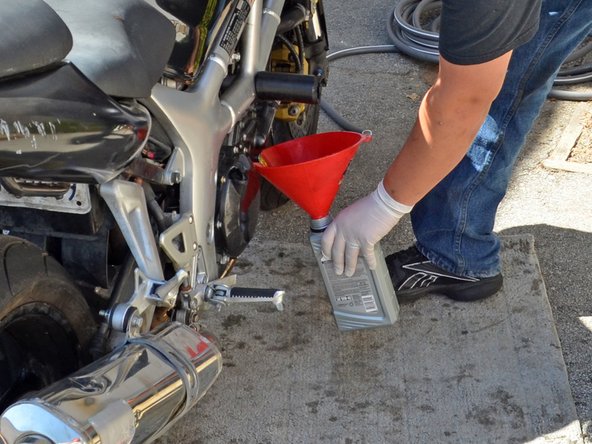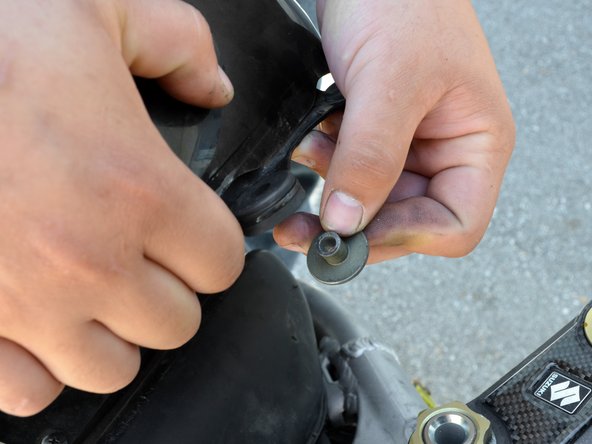Esta versão pode conter edições incorretas. Mude para o último instantâneo verificado.
O que você precisa
-
Este passo não foi traduzido. Ajude a traduzi-lo
-
Remove the radiator cap security screw with a Phillips #1 screw driver by turning it counter-clockwise.
-
Remove the radiator cap by pressing down on it and turning it counter-clockwise until it can be lifted off the radiator.
-
-
Este passo não foi traduzido. Ajude a traduzi-lo
-
Locate the 10 mm hex coolant drain plug. It is on the right engine cover, just below the coolant outlet.
-
Turn the coolant drain plug counter-clockwise with a 10 mm socket wrench or box end wrench until it can be turned freely by hand.
-
Place a container under the drain plug to catch the coolant when it streams out of the coolant drain hole.
-
-
Este passo não foi traduzido. Ajude a traduzi-lo
-
Finish removing the drain plug by hand and allow the coolant to drain into the container.
-
Once the draining coolant has slowed to a drip, stand the bike up vertically to allow the last of it to drain.
-
-
Este passo não foi traduzido. Ajude a traduzi-lo
-
Put the coolant drain plug back in its hole and turn it clockwise with a socket wrench or box end wrench until it is snug.
-
Place the radiator cap back over the filler hole and turn it clockwise until is snug.
-
-
Este passo não foi traduzido. Ajude a traduzi-lo
-
If you have frame covers below your seat, remove them by removing the 4 mm allen bolts holding them on. Use a 4 mm allen wrench to turn the screws counter-clockwise until they come off.
-
Once the frame covers are off, remove the 4 mm allen seat bolts on both sides of the seat. Use the 4 mm allen wrench to turn the screws counter-clockwise until they come off.
-
Lift the front of the seat, then pull it off the frame.
-
-
Este passo não foi traduzido. Ajude a traduzi-lo
-
Turn the two 4mm allen bolts in the front tank mounts counter-clockwise with an allen wrench until they come out.
-
Turn the two 12mm hex bolts in the tank's hinge base counter-clockwise with a socket wrench or box end wrench until they come out.
-
-
Este passo não foi traduzido. Ajude a traduzi-lo
-
Disconnect the fuel level sensor connector, located near the tank hinge base. It will be a three wire connector and one side of the wire will be traceable to the underside of the tank.
-
Carefully lift the front of the tank to gain access to the hoses attached to the tank.
-
-
Este passo não foi traduzido. Ajude a traduzi-lo
-
Locate the petcock on the left underside of the tank. It hill have 2 hoses attached to it and will be next to the fuel level sensor.
-
Disconnect the vacuum hose from the petcock.
-
Disconnect the fuel hose from the petcock
-
Disconnect the tank breather hose from the base of the tank.
-
-
Este passo não foi traduzido. Ajude a traduzi-lo
-
Carefully lift the tank up and off the frame of the bike, being sure that the fuel level sensor wire does not get caught in the frame.
-
-
-
Este passo não foi traduzido. Ajude a traduzi-lo
-
Remove the 10 mm hex radiator mounting bolts, on the top left side of the radiator, the top right side of the radiator and the bottom right side of the radiator.
-
-
Este passo não foi traduzido. Ajude a traduzi-lo
-
Loosen the hose clamp attached to the right side radiator oulet by turning the bolt counter-clockwise with a Phillips #1 screwdriver, a 6 mm socket wrench or a 6 mm box end wrench.
-
Slide the hose clamp down the radiator hose, away from the radiator outlet.
-
Carefully pull the radiator hose off the radiator outlet. Slightly twisting the hose left and right to "walk" the hose off the outlet may help if it is stuck.
-
-
Este passo não foi traduzido. Ajude a traduzi-lo
-
Loosen the hose clamp attached to the left side radiator inlet by turning the bolt counter-clockwise with a Phillips #1 screwdriver, a 6 mm socket wrench or a 6 mm box end wrench.
-
Carefully pull the radiator hose off the radiator inlet. Slightly twisting the hose left and right to "walk" the hose off the inlet may help if it is stuck.
-
-
Este passo não foi traduzido. Ajude a traduzi-lo
-
Unbend the wire holder on the inside of the front right of the frame to get slack in the wires attached to the radiator.
-
Carefully move the radiator to the right side of the bike, out of the way of the cylinder head.
-
-
Este passo não foi traduzido. Ajude a traduzi-lo
-
Remove the spark plug cap from cylinder 1 by grabbing the plug cap boot and pulling straight out.
-
Use a 5/8" spark plug driver, a socket extension and a socket wrench to remove the spark plug. Press the spark plug driver firmly onto the spark plug until you feel it "grab" the plug and turn it counter-clockwise until you can pull it out of the cylinder head.
-
-
Este passo não foi traduzido. Ajude a traduzi-lo
-
Insert the new spark plug into the spark plug driver. Press it in firmly so that the rubber insert grips the plug and doesn't allow it to fall out when turned upside down.
-
Place the spark plug into the spark plug hole and turn it clockwise until you feel the gasket seat. Give the wrench approximately 1/4 to 1/2 a turn clockwise from the seated position to snug up the spark plug.
-
Place the spark plug cap on the new spark plug. Press the cap on firmly until you feel it fully seat.
-
-
Este passo não foi traduzido. Ajude a traduzi-lo
-
Move the radiator back to its original position.
-
Wipe dirt and debris off the radiator inlet and outlet with a clean rag.
-
Insert the 10 mm hex radiator mounting bolts into the two top mounting points. Screw these bolts in a few turns by hand, but leave them loose enough to allow the radiator to rotate back and forth.
-
-
Este passo não foi traduzido. Ajude a traduzi-lo
-
Slide the left radiator hose back onto the radiator inlet.
-
Move the hose clamp back over the hose/radiator inlet and turn the clamp bolt clockwise, with a 6 mm socket, 6 mm box end wrench or Phillips #1 screwdriver, until the hose clamp is snug.
-
-
Este passo não foi traduzido. Ajude a traduzi-lo
-
Slide the right radiator hose back onto the radiator outlet.
-
Move the hose clamp back over the hose/radiator outlet and turn the clamp bolt clockwise, with a 6 mm socket, 6 mm box end wrench or Phillips #1 screwdriver, until the hose clamp is snug.
-
-
Este passo não foi traduzido. Ajude a traduzi-lo
-
Insert the bottom right radiator mounting bolt and turn it clockwise by hand a few turns.
-
Tighten the three radiator mounting bolts by turning them clockwise with a 10mm socket wrench or box end wrench until they are snug.
-
Re-wrap the wires in the wire holder to prevent them from shifting while riding.
-
-
Este passo não foi traduzido. Ajude a traduzi-lo
-
Remove the spark plug cap from cylinder 2. Remember to not pull it by its wire!
-
Use a 5/8" spark plug driver, a socket extension and a socket wrench to remove the spark plug. Press the spark plug driver firmly onto the spark plug until you feel it "grab" the plug and turn it counter-clockwise until you can pull it out of the cylinder head.
-
-
Este passo não foi traduzido. Ajude a traduzi-lo
-
Check and adjust the new spark plug's gap as described in step 15.
-
Put the new spark plug in the spark plug driver and insert it into the spark plug hole.
-
Turn the spark plug clockwise until the spark plug gasket seats. Turn the spark plug 1/4 to 1/2 a turn clockwise from the seated position.
-
Firmly press the spark plug cap onto the new spark plug until you feel it fully seat.
-
-
Este passo não foi traduzido. Ajude a traduzi-lo
-
Gently set the tank back into place.
-
Rotate the tank forward and re-attach the tank breather hose.
-
Route the fuel level sensor wire between the frame and underneath the tank hinge, being sure that it is not tangling or interfering with any other wires or hoses. Reconnect the fuel level sensor.
-
-
Este passo não foi traduzido. Ajude a traduzi-lo
-
Lift the front of the tank slightly.
-
Re-attach the fuel hose.
-
Re-attach the vacuum hose.
-
Gently lower the tank until it rests on the frame.
-
-
Este passo não foi traduzido. Ajude a traduzi-lo
-
Align the bolt holes of the tank hinge base.
-
Place the hinge base bolts into their holes and turn them clockwise by hand a few turns. Do not tighten them yet.
-
Align the the front mounting bolt holes and place the front mounting bolts into their respective holes. Turn the bolts clockwise by hand a few turns.
-
Tighten the four tank mounting bolts with a 10mm socket wrench or box end wrench until snug.
-
-
Este passo não foi traduzido. Ajude a traduzi-lo
-
Slide the seat into place, back end first. Make sure the plastic hooks on the back of the seat slide under the metal bar in the sub-frame.
-
Insert the seat bolts and turn them clockwise until they are snug.
-
If you have frame covers, reposition them into their appropriate spots, insert their bolts and turn the bolts clockwise until they are snug.
-
-
Este passo não foi traduzido. Ajude a traduzi-lo
-
Remove the radiator cap again and insert a funnel into the radiator filler hole.
-
Pour approximately 1.7 quarts of coolant into the radiator or fill until you can see coolant near the filler neck. Use one hand to stabilize the funnel to prevent spills.
-
-
Este passo não foi traduzido. Ajude a traduzi-lo
-
Remove the funnel and place the radiator cap back over the radiator filler hole. Press down on the cap and turn it clockwise until it is snug.
-
Insert and turn the radiator cap security screw clockwise until it is snug.
-
Start the bike, look for excessive vibration and listen for any irregular noises such as ticking or knocking that were not previously present. If something is not right, shut the bike off quickly to prevent potential damage.
-
Cancelar: não concluí este guia.
12 outras pessoas executaram este guia.
5 comentários
Need to change plug
Awesome guide. Very helpful. Thanx a
Which ways are the arrows supposed to face on the rubber end of the coil that connects to the plug
Excellent instructions , thank you very much!!!
Thanks, Phil, happy trails.

































































